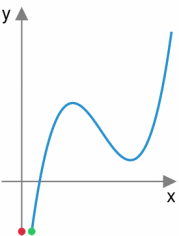 | ||
In mathematics, the total variation identifies several slightly different concepts, related to the (local or global) structure of the codomain of a function or a measure. For a real-valued continuous function f, defined on an interval [a, b] ⊂ ℝ, its total variation on the interval of definition is a measure of the one-dimensional arclength of the curve with parametric equation x ↦ f(x), for x ∈ [a, b].
Contents
- Historical note
- Total variation for functions of one real variable
- Total variation for functions of n 1 real variables
- Classical total variation definition
- Modern definition of total variation norm
- Total variation norm of complex measures
- Total variation norm of vector valued measures
- Total variation of probability measures
- Total variation of differentiable functions
- The form of the total variation of a differentiable function of one variable
- The form of the total variation of a differentiable function of several variables
- Total variation of a measure
- Applications
- References
Historical note
The concept of total variation for functions of one real variable was first introduced by Camille Jordan in the paper (Jordan 1881). He used the new concept in order to prove a convergence theorem for Fourier series of discontinuous periodic functions whose variation is bounded. The extension of the concept to functions of more than one variable however is not simple for various reasons.
Total variation for functions of one real variable
Definition 1.1. The total variation of a real-valued (or more generally complex-valued) function
where the supremum runs over the set of all partitions
Total variation for functions of n > 1 real variables
Definition 1.2. Let Ω be an open subset of ℝn. Given a function f belonging to L1(Ω), the total variation of f in Ω is defined as
where
Classical total variation definition
Following Saks (1937, p. 10), consider a signed measure
clearly
Definition 1.3. The variation (also called absolute variation) of the signed measure
and its total variation is defined as the value of this measure on the whole space of definition, i.e.
Modern definition of total variation norm
Saks (1937, p. 11) uses upper and lower variations to prove the Hahn–Jordan decomposition: according to his version of this theorem, the upper and lower variation are respectively a non-negative and a non-positive measure. Using a more modern notation, define
Then
The last measure is sometimes called, by abuse of notation, total variation measure.
Total variation norm of complex measures
If the measure
Definition 1.4. The variation of the complex-valued measure
where the supremum is taken over all partitions
This definition coincides with the above definition
Total variation norm of vector-valued measures
The variation so defined is a positive measure (see Rudin (1966, p. 139)) and coincides with the one defined by 1.3 when
where the supremum is as above. Note also that this definition is slightly more general than the one given by Rudin (1966, p. 138) since it requires only to consider finite partitions of the space
Total variation of probability measures
The total variation of any probability measure is exactly one, therefore it is not interesting as a means of investigating the properties of such measures. However, when μ and ν are probability measures, the total variation distance of probability measures can be defined as
and its values are non-trivial. The factor
Total variation of differentiable functions
The total variation of a differentiable function
The form of the total variation of a differentiable function of one variable
Theorem 1. The total variation of a differentiable function
The form of the total variation of a differentiable function of several variables
Theorem 2. Given a differentiable function
Here
Proof
The first step in the proof is to first prove an equality which follows from the Gauss–Ostrogradsky theorem.
Lemma
Under the conditions of the theorem, the following equality holds:
Proof of the lemma
From the Gauss–Ostrogradsky theorem:
by substituting
where
Proof of the equality
Under the conditions of the theorem, from the lemma we have:
in the last part
On the other hand we consider
This means we have a convergent sequence of
It can be seen from the proof that the supremum is attained when
The function
Total variation of a measure
The total variation is a norm defined on the space of measures of bounded variation. The space of measures on a σ-algebra of sets is a Banach space, called the ca space, relative to this norm. It is contained in the larger Banach space, called the ba space, consisting of finitely additive (as opposed to countably additive) measures, also with the same norm. The distance function associated to the norm gives rise to the total variation distance between two measures μ and ν.
For finite measures on ℝ, the link between the total variation of a measure μ and the total variation of a function, as described above, goes as follows. Given μ, define a function
Then, the total variation of the signed measure μ is equal to the total variation, in the above sense, of the function φ. In general, the total variation of a signed measure can be defined using Jordan's decomposition theorem by
for any signed measure μ on a measurable space
Applications
Total variation can be seen as a non-negative real-valued functional defined on the space of real-valued functions (for the case of functions of one variable) or on the space of integrable functions (for the case of functions of several variables). As a functional, total variation finds applications in several branches of mathematics and engineering, like optimal control, numerical analysis, and calculus of variations, where the solution to a certain problem has to minimize its value. As an example, use of the total variation functional is common in the following two kind of problems
